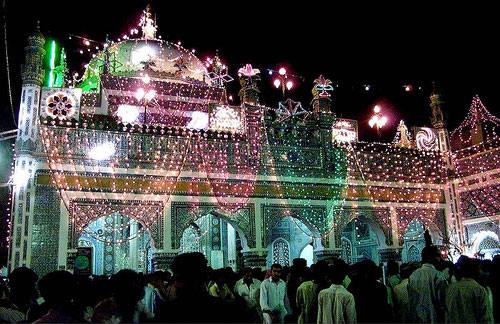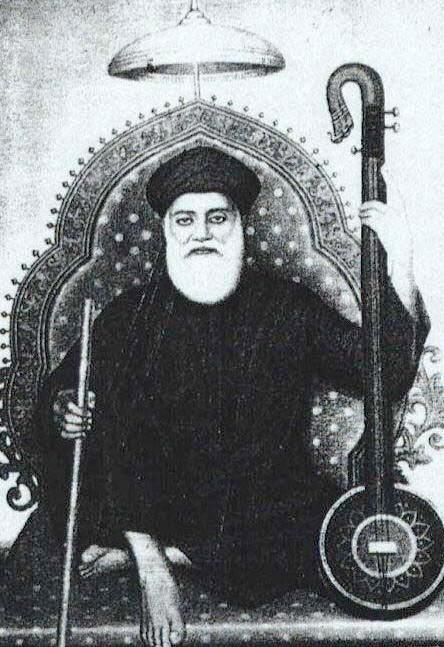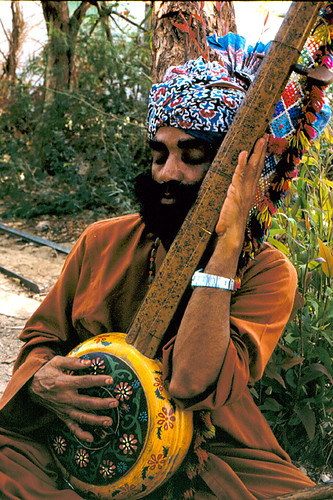The mosque that is built in the hearts of the saints Is the place of worship for all, for God dwells there (Jalaluddin Rumi)
The real name of ‘Lal Shahbaz Qalandar’ was Syed Muhammad Usman who was born in 1177 AD in Marwand, Iran. His father, Syed Ibrahim Kabiruddin, was a virtuous and pious dervish, and his mother was a high-ranking princess. His ancestors migrated from Iraq and settled down in Meshed, from where they again migrated to Marwand. During the Medieval period, Meshed and other cities of that region were renowned centers of learning and civilization.
Even as a young boy, Shahbaz Qalandar showed strong religious leanings. He learnt the Holy Quran by heart just at age of seven, and at twenty embraced the Qalandar order of Sufism. ‘Qalandar’ is a type of dervish who is generally dressed in beggars’ clothes, likes poverty and austerity and has no permanent dwelling. Lal Shahbaz Qalandar wandered throughout Middle East and came to Sind from Baghdad via Dasht-i-Makran. In 1263, he arrived in Multan, which at that time was at the height of glory and splendor. The people of Multan besought him to stay but he continued his journey southward and eventually settled down in Sehwan, then a famous center of learning and popular place of worship for Hindus, in the southern part of Sindh, where he lived in the trunk of a tree on the outskirts of the town. He stayed at Sehwan for six years and during this period he disseminated the light of Islam, providing guidance to thousands of people.
Sehwan is probably the town with the oldest continuous existence in Sind.It rises on the top of a conical hill, and nearby lie the ruins of a huge fort believed to have been founded by Alexander the Great. Some coins of Alexander’s time are reported to have been found here. Sehwan was the capital of a Buddhist ruler who was brother of Chandragupta II, the third of the Guptan dynasty in the 4th century AD. From the time of Arab invasion in 712, Sehwan was very important in the history of Sind since it commanded the route from the Upper to the Lower Indus, through which all invaders from either north or south had to pass. And possession of the fort was essential to the success of every campaign.
Lal Shahbaz Qalandar is an overwhelmingly popular patron saint cherished and adored alike by Hindus and Muslims of Sind. He was a great missionary, mystic, scholar, philologist and poet. Several books in Persian and Arabic on philology and poetry are attributed to him. He was ‘Lal’ (red) because of his red attire, ‘Shahbaz’ due to his noble and divine spirit that soared like a falcon higher and higher in the boundless heavens and ‘Qalandar’ since he belonged to Qalandria order of Sufism and was saintly, exalted and intoxicated with love for eternal being of God. The legend goes that the incumbent fakirs in Sewhan sent him a bowl of milk filled to the brim indicating that there was no room for anything more. But surprisingly, he returned the bowl with a beautiful flower floating on the top. This legend spread far and wide by the time of his death in 1274, after living a good span for 97 years.
The shrine around his tomb, built in 1356, gives a dazzling look with its Sindhi kashi tiles, mirror work and two gold-plated doors - one donated by the late Shah of Iran, the other by the late Prime Minister Zulfikar Ali Bhutto. The inner sanctum is about 100 yards square with the silver canopied grave in the middle. On one side of the marble floor is a row of about 12 inch high folding wooden stands on which are set copies of Quran for devotees to read. On the other side, beside a bundle of burning agarbattis (joss sticks), are rows of diyas (small oil lamps) lighted by Hindu devotees. The Hindus regarded him as the incarnation of Bhartihari, the saintly brother of King Vikramaditya, who is believed to have worshipped Shiva at the venue where Lal Shahbaz's shrine is situated with all its grandeur and glory.
Thousands of devotees flock to the tomb while every Thursday their number stands multiplied. Especially at the time of his ‘Urs’ (death anniversary) being a carnival as well a religious festival and celebrated every year on the 18th day of Sha’ban, Sehwan springs to life and becomes the focal point of more than half a million pilgrims from all over Pakistan. On each morning of the three day feast, the narrow lanes of Sewhan are packed to capacity as thousands and thousands of pilgrims, fakirs and devotees make their way to the shrine to commune with the saint, offer their tributes and make a wish. Most of the people present garlands and a green chadar (a cloth used to cover a tomb) with Qur’anic inscriptions in silver or gold threads. Humming of verses, singing and dancing in praise of the saint continues till late at night. A devotional dance known as ‘dhamal’, being a frenzied and ecstatic swirl of the head and body, is a special ritual that is performed at the rhythmic beat of the dhole (a big barrel-shaped drum), some of them being of giant size and placed in the courtyard of the shrine. Bells, gongs, cymbals and horns make a thunderous din, and the dervishes, clad in long robes, beads, bracelets and colored head-bands whirl faster and faster in a hypnotic trance, until with a final deafening scream they run wildly through the doors of the shrine to the courtyard beyond.
Not only the people congregating from all over Pakistan but also the tourists and the foreigners are enthralled at this fascinating scene and aspire to enjoy it time and again. Such were the persons who really attained the lofty mystical experience. Through their transcendence, their relation to God is such that in them the Divine personality seems to reflect itself and through them is revealed to his followers, and the grace of God is dispensed to those who invoke God in his name. In Iqbal’s inspirational poetry we find so many verses about who is Qalandar and what are the attributes of a Qalandar. A few instances are as below:









 THREE SWEET SINDHI KIDS WEARING SINDHI CULTURAL CAP & SINDHI CULTURAL SHAWL " AJRAK"
THREE SWEET SINDHI KIDS WEARING SINDHI CULTURAL CAP & SINDHI CULTURAL SHAWL " AJRAK"
 SINDHI CULTURAL SHAWL CALLED "AJRAK"
SINDHI CULTURAL SHAWL CALLED "AJRAK"
 EVERY SINDHI PEOPLE USING SINDHI CAP USUALLY / OCCASIONALLY BECAUSE IT IS CULTURAL CAP OF SINDHI PEOPLE, THEY PUT ON HAD & PROUD IT & SINDHI PEOPLE GIVES GIFT TO THEIR GUEST OR FRIENDS.SINDHI PEOPLE SAID IT IS SYMBOL OF OUR HONOR.
EVERY SINDHI PEOPLE USING SINDHI CAP USUALLY / OCCASIONALLY BECAUSE IT IS CULTURAL CAP OF SINDHI PEOPLE, THEY PUT ON HAD & PROUD IT & SINDHI PEOPLE GIVES GIFT TO THEIR GUEST OR FRIENDS.SINDHI PEOPLE SAID IT IS SYMBOL OF OUR HONOR.
 "AJRAK" RICHEST CULTURAL SCARF/SHAWL OF SINDHI PEOPLES , HUGE NUMBERS OF SINDHI PEOPLES PUT ON THEIR SHOULDERS & THEY PROUD ON IT
"AJRAK" RICHEST CULTURAL SCARF/SHAWL OF SINDHI PEOPLES , HUGE NUMBERS OF SINDHI PEOPLES PUT ON THEIR SHOULDERS & THEY PROUD ON IT










 Tomb of Hazrat Sachal Sarmast R.A which is situated at Daraza Sharief a area / Town of District Khair Pur Mirus , Sindh , Pakistan
Tomb of Hazrat Sachal Sarmast R.A which is situated at Daraza Sharief a area / Town of District Khair Pur Mirus , Sindh , Pakistan
 The great soofi saint of Pakistan
The great soofi saint of Pakistan



























